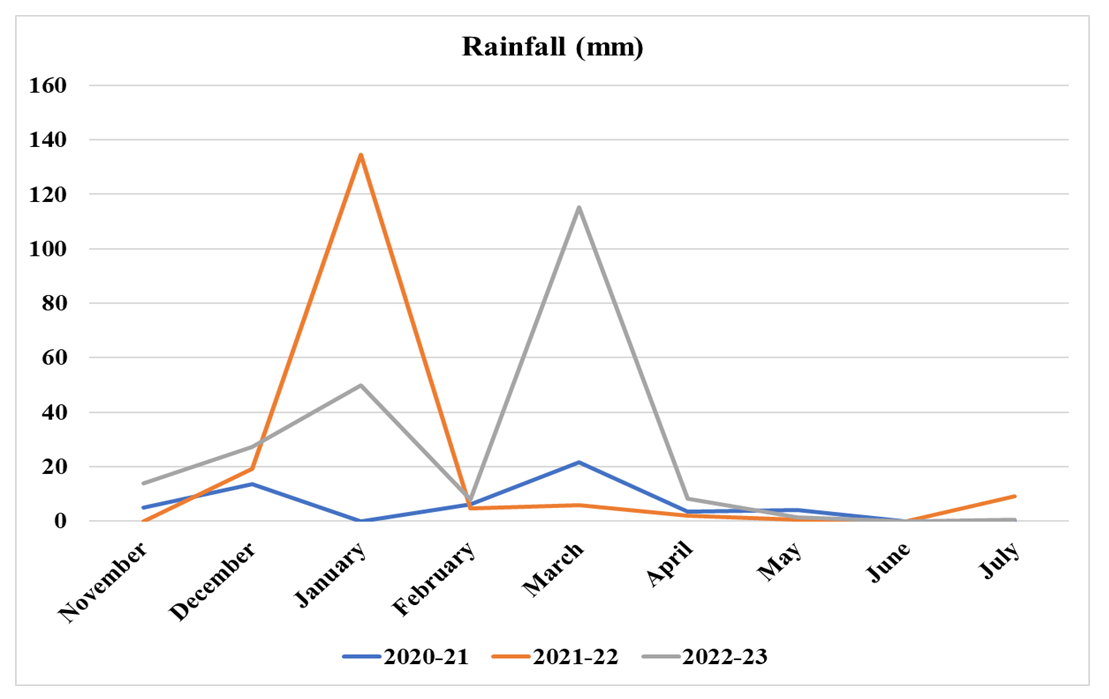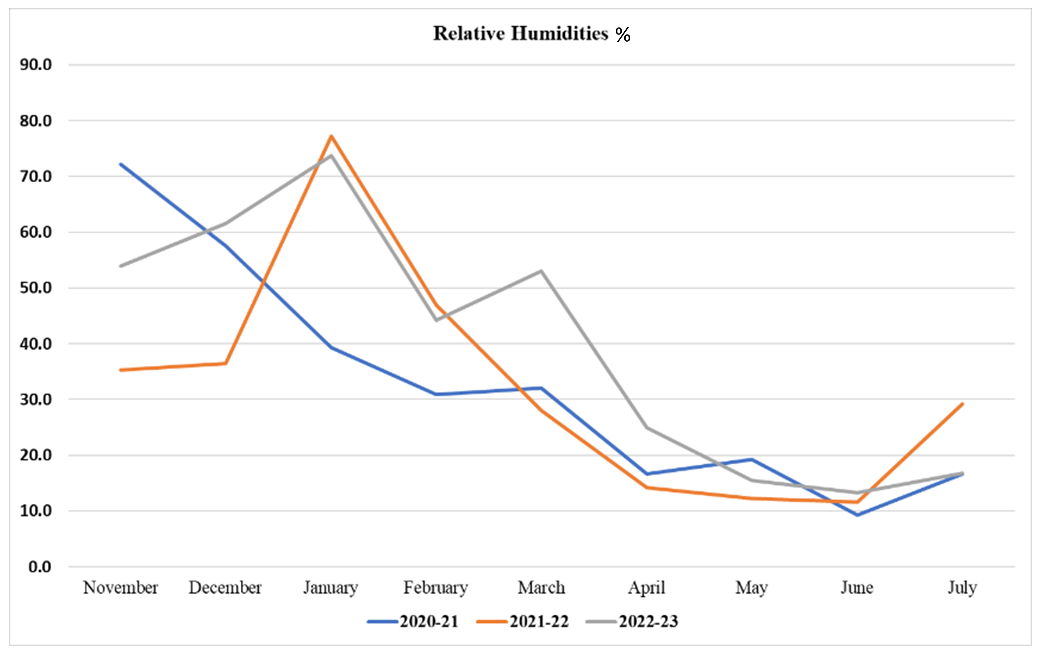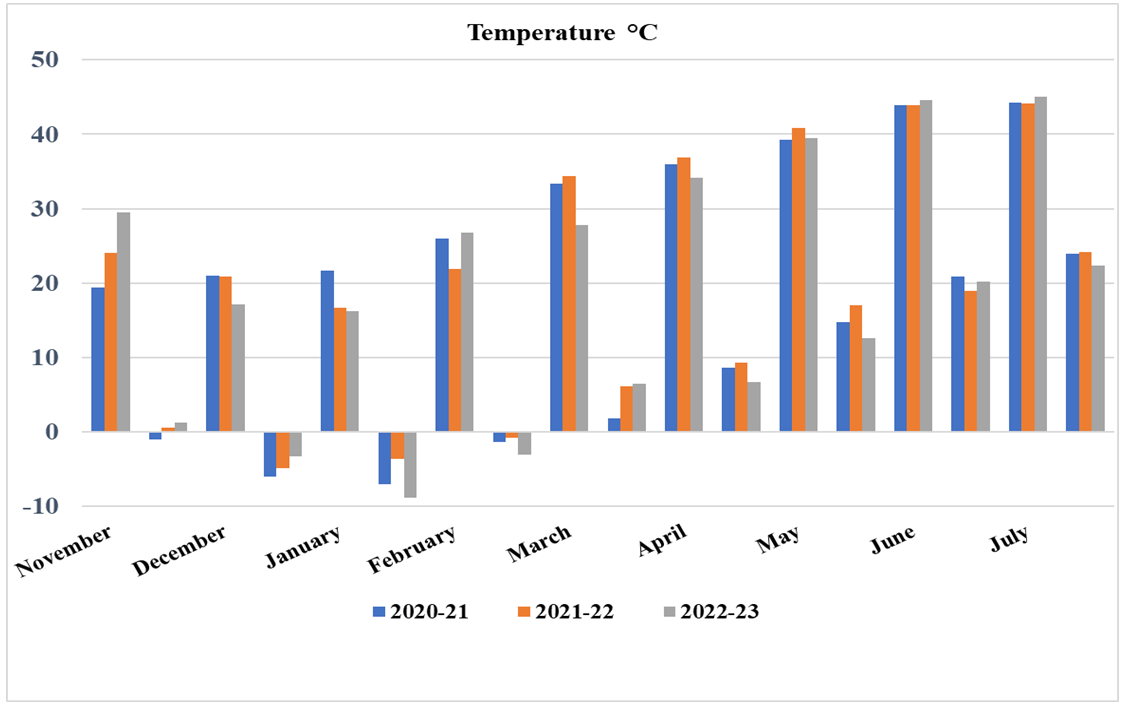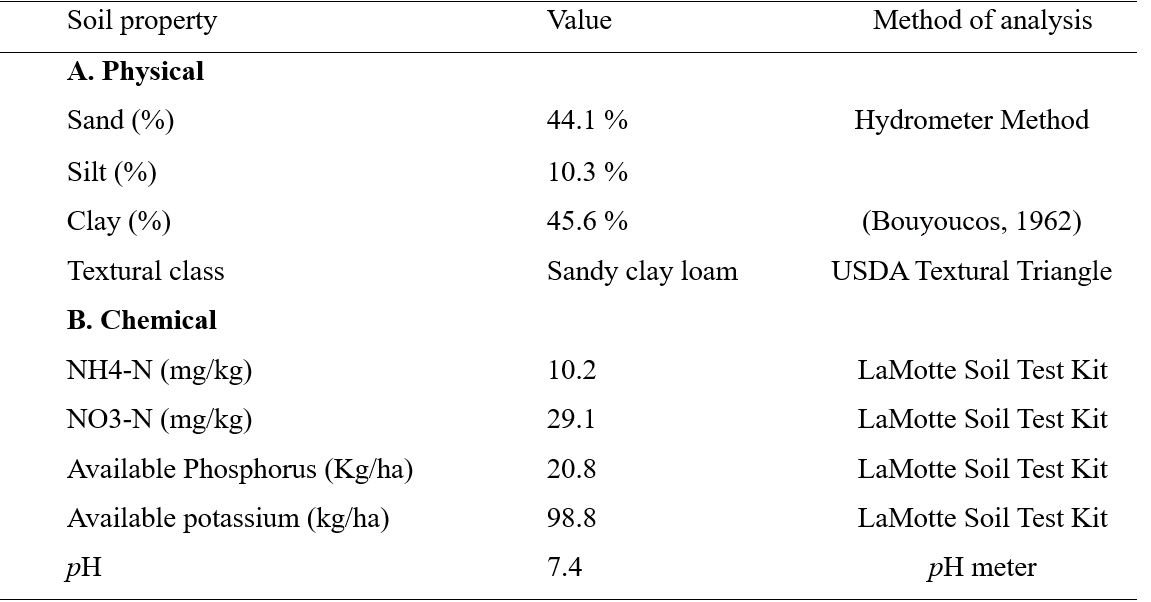Wheat Growth and Productivity Depending on Levels of NPK When Grown in Kandahar Conditions in Afghanistan
Wheat Growth and Productivity Depending on Levels of NPK When Grown in Kandahar Conditions in Afghanistan
Abstract
In the conditions of the field experimental station of the National Agricultural Research Technological University of Afghanistan (ANASTU), field research was carried out using generally accepted methods.
The purpose of the research: to study the influence of different levels of mineral nutrition (NPK) on the growth and formation of yield of wheat plants of the Chont 01 variety.
Studies have examined various combinations of different doses of nitrogen, phosphorus and potassium in wheat production. The following options were included in the experimental design: T0 (0-0-0 NPK), T1 (70-30-30 NPK), T2 (70-30-60 NPK), T3 (70-60-30 NPK), T4 (70 -60-60 NPK), T5 (140-30-30 NPK), T6 (140-30-60 NPK), T7 (140-60-30 NPK) and T8 (140-60-60 NPK) kg/ha. The control was the option without applying fertilizers (absolute control). Treatments were arranged using a randomized complete block design (RCBD) in triplicate to ensure unbiased results.
Research results. The results obtained demonstrated the effectiveness of different levels of mineral nutrition on wheat yield. The maximum possible wheat yield under these growing conditions was obtained in the T9 variant, where N140 P60 K 60 was applied. The increase in grain yield was 55% compared to the control variant without the use of fertilizers.
1. Introduction
Wheat (Triticum aestivum L.) belongs to the tribe Triticeae in the grass family Poaceae (Gramineae), which includes major cereal crops, and is one of the eight food sources (wheat, rice, corn, sugar, cattle, sorghum, millet and cassava) which provides 70-90% of all calories and 66-90% of the protein consumed in developing countries. Globally, wheat is the most important staple food for 40% of the population , . Its grain is a staple food used to make flour for leavened, flat and steamed breads, biscuits, cookies, cakes, breakfast cereal, pasta, noodles, etc. and for fermentation to make beer, alcohol, vodka, or biofuel. It is also used for feeding animals, especially it is a good source of food feed component of large cattle population in the world. Currently, about 90% of the world's wheat production is used for food purposes, and the rest of the grain is used for seed production, for the production of starch, malt, dextrose, gluten, and for the production of whiskey and beer. In recent years, technologies for extracting cellulose and other important chemical and biologically active substances from wheat straw have begun to be actively studied. The area of arable land in Afghanistan is about 7.6 million hectares. The main agricultural grain crops in the country are wheat, rice, barley and corn. Wheat accounts for almost 80% of Afghanistan's grain harvest. Thus, wheat is the most important crop for the country’s food security . The sown area under grain crops in the country is (% of the total sown area): wheat – 29%; rice – 1.7%; barley – 2.5%; corn – 1.9% . The wheat production of Afghanistan has ranged from 2.6 to 5.2 million tones . According to the estimates provided by the FAO in 2017, the average productivity of wheat in Afghanistan was recorded at 1.96 t/ha. This figure is significantly lower than the global average wheat productivity, which stands at 3.48 tons per hectare (t/ha).
In Afghanistan, wheat is cultivated in two seasons; in spring and fall, and most of the wheat area and production is in the northern parts of the country. SHESHAMBAGH-08, BAKHTAR-013, DORAKSHAN-08, ROSHAN-96, MUQAWIM-09 and CHONTE #1 are some famous wheat varieties cultivating in different provinces of Afghanistan . However, the productivity of wheat in Afghanistan remains low due to challenges such as uneven rainfall distribution and a lack of suitable crop production technologies. The major fertilizers used for wheat in Afghanistan are nitrogen in the form of Urea (46%N) and phosphorus in the form of DAP (Diammonium phosphate 46%P2O5 + 18%N), which are applied at varying rates. However, the lack of knowledge regarding the optimal dosage of nitrogen, phosphorus, and potassium application in wheat results in nutrient loss and subsequently lower wheat productivity. To address these challenges, implementing optimized nutrient management practices becomes crucial. By adopting appropriate fertilization strategies and ensuring balanced nutrient application, nutrient deficiencies can be overcome, leading to improved wheat growth and yield. This emphasizes the importance of conducting research and disseminating knowledge about optimum nutrient management practices tailored to the specific conditions in Afghanistan.
2. Research methods and principles
The experiment was conducted at the farm of Afghanistan National Agricultural Sciences and Technology University, Kandahar (65o52' 1" E" 31o26' 58" N’ 986 m above the mean sea” level), Afghanistan which is located in southern Afghanistan, characterized by a semi-arid to subtropical climate with extreme variations in temperature. The average annual rainfall in the region is 190.6 mm. Minimum/maximum temperature average rainfall, relative humidity and wind speed observations during the study period is depicted in Fig 1, Fig 2, Fig 3, Fig 4.
The soil at the experimental site had a sandy-clay loam texture and was almost neutral in pH (pH 7.24). The soil was characterized as low in available nitrogen, medium in P2O5, and high in K2O/ha. The experiment was laid out in a randomized block design with 9 treatment combinations, including consisting of 2 Nitrogen levels (70 and 140 kg N/ha), 2 phosphorus levels (30 and 60 kg P2O5/ha), 2 potassium levels (30 and 60 kg K2O/ha) and 1 absolute control replicated three times. Nitrogen, phosphorus, and potassium nutrients were applied using Urea, Diammonium phosphate and potassium sulphate. Each plot had a size of 3 m × 4 m, with a total area of 12 m2. The wheat crop (Chot 01) was sown during the third week of November and harvested in the second week of July for all seasons studied in the investigation, and the 125 Kg/ha seed rate was used. Wheat seeds were treated with Vitavax, to protect against fungal diseases. Statistical analysis was done by the standard procedures, as suggested by Gomez and Gomez (1984). Critical difference (CD) values at P=0.05 were used to determine the significant differences between treatment means.

Figure 1 - Agrometeorological data when conducting experiments on the territory of Afghanistan National Agriculture Science and Technology University, Kandahar in 2021–2023 (rainfall)

Figure 2 - Agrometeorological data when conducting experiments on the territory of Afghanistan National Agriculture Science and Technology University, Kandahar in 2021–2023 (relative humidities)

Figure 3 - Agrometeorological data when conducting experiments on the territory of Afghanistan National Agriculture Science and Technology University, Kandahar in 2021–2023 (temperature)

Figure 4 - Agrometeorological data when conducting experiments on the territory of Afghanistan National Agriculture Science and Technology University, Kandahar in 2021–2023 (wind speed)
3. Main results: soil characteristics
The soil of the experimental plot is characterized in its texture as sandy loam soil, the acidity of the soil is close to neutral or slightly acidic (pH = 7.42). According to agrochemical analysis, it was established that in the soil per 1 hectare there is a low content of available nitrogen, an average content of phosphorus (P2O5) and a high content of potassium (K2O) (Fig. 5).

Figure 5 - Physical, physico-chemical and agrochemical characteristics of the soil of the experimental plot
Table 1 - The influence of basic nutrients on the morphophysiological characteristics of wheat in the semi-arid conditions of Kandahar, Afghanistan in 2021–2023
Treatment | Plant Height, cm, Average 2021-2023 | Spike/m2, Average 2021-2023 |
Absolute control | 67.6 | 222.5 |
N1, P1, K1 | 76.6 | 306.8 |
N1, P1, K2 | 78.3 | 314.7 |
N1, P2, K1 | 80.9 | 317.8 |
N1, P2, K2 | 79.6 | 327.3 |
N2, P1, K1 | 81.8 | 321.8 |
N2, P1, K2 | 83.4 | 337.7 |
N2, P2, K1 | 86.6 | 348.0 |
N2, P2, K2 | 88.1 | 359.4 |
SEm± | 1.10 | 7.6 |
CD (P=0.05) | 3.3 | 22.9 |
4. Discussion
Table 2 - Effect of essential nutrients on wheat yield in semi-arid conditions of Kandahar, Afghanistan in 2021–2023
Treatment | Grain/Spike, Average 2021-2023, kg/ha | 1000 Grain Weight, Average 2021-2023, g | Grain Yield, Average 2021-2023, kg/ha |
Absolute control | 36.1 | 34.9 | 1.8 |
N1, P1, K1 | 40.1 | 37.3 | 2.5 |
N1, P1, K2 | 39.9 | 38.9 | 2.6 |
N1, P2, K1 | 41.2 | 38.6 | 2.8 |
N1, P2, K2 | 40.3 | 38.1 | 2.6 |
N2, P1, K1 | 42.3 | 38.8 | 2.8 |
N2, P1, K2 | 45.7 | 41.1 | 3.3 |
N2, P2, K1 | 46.0 | 42.4 | 3.7 |
N2, P2, K2 | 49.0 | 42.8 | 4.1 |
SEm± | 1.19 | 0.6 | 0.3 |
CD (P=0.05) | 5.7 | 1.8 | 0.8 |
Plant Height (cm):
The analysis of variance demonstrated significant differences among the various NPK levels. The application of NPK at a rate of 140-60-60 kg/ha resulted in the maximum plant height of 88.1 cm, while the treatment without any fertilizer exhibited the minimum plant height. It was observed that plant height increased linearly with each incremental increase in NPK dosage, which can be attributed to a gradual enhancement in plant growth. The outcomes of the present study confirm the findings of Solodushko et al., (2022) and Dreisigacker et al., (2019) ,
.Number of spikes plant-1:
The data analysis for the number of spikes per square meter indicated significant variations among the different fertilizer treatments. The application of NPK at a dose of 140-60-60 kg/ha resulted in the highest number of spikes per square meter (359.4), while the control treatment yielded the lowest number of spikes per square meter (222.5). The increased in number of spikes per plant with higher NPK levels was also reported by Hemeid et al., (2020)
.Number of grains spikes-1:
Treatment T9, which employed the application of NPK fertilizer at a rate of 140-60-60 kg/ha, exhibited the highest number of grains per spike (49), surpassing T8 (140-60-30 kg/ha) with 46 grains per spike. In contrast, the control treatment (T0) had the lowest number of grains per spike, averaging at 36.1 ,
.1000 grain weight:
Significant variations in 1000-grain weight were observed among the different NPK treatments. Treatment T9 achieved the highest weight of 42.8g, followed by T8 42.4g and T7 41.1g. In contrast, the control treatment T0 displayed a significantly lower 1000-grain weight of 34.9g compared to T9, T8, and T7 .
Grain yield:
Grain yield of wheat was significantly influenced by the application of NPK, as shown in Table 3. The treatment with NPK 140-60-60 kg/ha resulted in the highest grain yield (4093 kg/ha). These findings confirm the results of previous studies conducted by Denisov et al. (2023) and Finch et al. (2022) which demonstrated that increased NPK fertilization in wheat crops led to higher grain yield, straw yield, and overall biological yield.
5. Conclusion
Thus, we conducted a study on the use of various doses of mineral fertilizers when growing winter wheat in the agroclimatic conditions of the southern region of Afghanistan. The influence of different doses of NPK on the growth and development of wheat was assessed, and the optimal dose of NPK for obtaining a high grain yield was identified. Application of the most effective dose of NPK at a rate of 140-60-60 kg/ha leads to an increase in grain yield to 4 tons per 1 ha, which is 2 times higher than the average wheat grain yield in the country. These findings highlight the crucial role of NPK fertilization in maximizing wheat productivity.
In summary, proper nutrient management, specifically the application of NPK at 140-60-60 kg/ha, is essential for achieving optimal wheat production. By considering these findings, farmers can make informed decisions about fertilizer application to maximize their wheat yields.
